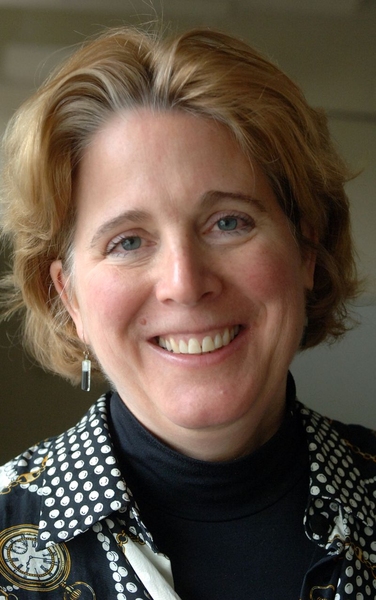Professor of Physics Jacqueline Hewitt will continue in her role as director of the MIT Kavli Institute for Astrophysics and Space Research (MKI), Marc Kastner, dean of the School of Science, announced this week. MKI is an interdepartmental center for research in space science and engineering, astronomy and astrophysics, and plays a leading role in the design, construction, and utilization of instruments for space vehicles and ground-based observatories. Hewitt, who has directed MKI since 2002, will begin her new three-year term on July 1, 2010.
MKI started life in 1965 as the Center for Space Research, but under Hewitt’s direction it became one of several Kavli Institutes at prestigious universities around the nation and the world. The result of a generous gift from the Kavli Foundation, the center’s transition into the MKI has played an essential role in maintaining and expanding MIT’s vibrant program in space research.
“Jackie has shown heroic leadership in an extraordinarily challenging time, in which NASA funding for university space programs have been declining,” said Kastner. “By securing an endowment from the Kavli Foundation to create the MIT Kavli Institute out of the illustrious Center for Space Research, she has given the MKI the chance to excel in what we believe will be better times ahead.”
Hewitt first joined MIT as a graduate student. She earned her PhD in 1986, completing the first large systematic survey of gravitational lenses for her doctoral thesis. The study of gravitational lenses, bends in light emitted from bright, distant objects created by massive objects, allowed scientists to better measure mass distribution at greater distances in space. After completing her PhD, she was hired by the MIT Haystack Observatory as a postdoctoral associate in the Very Long Baseline Interferometry group. In 1989 she joined the MIT faculty as an assistant professor of physics, where she continued to work on gravitational lenses, cosmology and surveys of transient astronomical radio emission. She also pioneered new astrophysical applications of radio astronomy, interferometry and image and signal processing.
In recent years, she has added observational signatures of the epoch of reionization to her topics of interest and is involved in the development of radio telescopes with large aperture and large field of view, which represent the "next generation" in radio astronomical instrumentation. In particular, she is part of a collaboration between U.S. and Australian researchers developing the Murchison Widefield Array, a low-frequency antenna array under construction in Western Australia.
Hewitt is delighted to continue in her role as director. “The best part of my job is working with our amazingly talented faculty, research staff and students to find new ways to address some of the most exciting questions in astrophysics,” says Hewitt. “We’re developing a satellite to find habitable planets around other stars — a radio telescope to detect the formation of the first galaxies — an infrared spectrometer to track the chemical enrichment of galaxies by the first stars. MIT has a wonderful intellectual environment for bringing these things together — from theory to soldering boards in the lab.”
MKI started life in 1965 as the Center for Space Research, but under Hewitt’s direction it became one of several Kavli Institutes at prestigious universities around the nation and the world. The result of a generous gift from the Kavli Foundation, the center’s transition into the MKI has played an essential role in maintaining and expanding MIT’s vibrant program in space research.
“Jackie has shown heroic leadership in an extraordinarily challenging time, in which NASA funding for university space programs have been declining,” said Kastner. “By securing an endowment from the Kavli Foundation to create the MIT Kavli Institute out of the illustrious Center for Space Research, she has given the MKI the chance to excel in what we believe will be better times ahead.”
Hewitt first joined MIT as a graduate student. She earned her PhD in 1986, completing the first large systematic survey of gravitational lenses for her doctoral thesis. The study of gravitational lenses, bends in light emitted from bright, distant objects created by massive objects, allowed scientists to better measure mass distribution at greater distances in space. After completing her PhD, she was hired by the MIT Haystack Observatory as a postdoctoral associate in the Very Long Baseline Interferometry group. In 1989 she joined the MIT faculty as an assistant professor of physics, where she continued to work on gravitational lenses, cosmology and surveys of transient astronomical radio emission. She also pioneered new astrophysical applications of radio astronomy, interferometry and image and signal processing.
In recent years, she has added observational signatures of the epoch of reionization to her topics of interest and is involved in the development of radio telescopes with large aperture and large field of view, which represent the "next generation" in radio astronomical instrumentation. In particular, she is part of a collaboration between U.S. and Australian researchers developing the Murchison Widefield Array, a low-frequency antenna array under construction in Western Australia.
Hewitt is delighted to continue in her role as director. “The best part of my job is working with our amazingly talented faculty, research staff and students to find new ways to address some of the most exciting questions in astrophysics,” says Hewitt. “We’re developing a satellite to find habitable planets around other stars — a radio telescope to detect the formation of the first galaxies — an infrared spectrometer to track the chemical enrichment of galaxies by the first stars. MIT has a wonderful intellectual environment for bringing these things together — from theory to soldering boards in the lab.”






